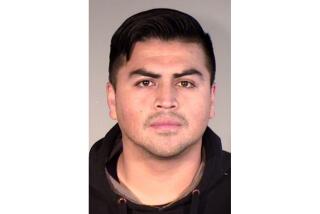Mishandling of abuse cases threatens Mahony’s legacy with Latinos
On a Sunday night at Dodger Stadium in 1986, Archbishop Roger M. Mahony celebrated Mass in flawless Spanish. In an era when immigrants in Los Angeles were routinely derided as parasites and criminals, the archbishop told the crowd of 55,000 that whether they were born in Puebla, San Salvador or Managua, they were part of his flock.
“The Catholic Church is your home and I am your pastor,” Mahony said.
But even as cheers of “Rogelio! Rogelio!” rained down from the upper decks, Mahony was covering up the sexual abuse of some of the most vulnerable in the church, including in his beloved Latino community, church records show.
Over the last four decades, hundreds of people have come forward to say they were abused by priests in the archdiocese. Children were victimized at parishes across the L.A. area, in poor neighborhoods as well as wealthy ones. But internal church documents released last week shined a spotlight on Mahony’s mishandling of two pedophile priests who abused the undocumented — a group the prelate often described as society’s most in need of protection. Mahony worked to make sure the priests got therapy, found new jobs and stayed out of prison. For the child victims, little was done.
The revelations threaten to tarnish his legacy of fighting for immigrants, an effort Mahony described as his calling and one that was widely acknowledged as a triumph in his tenure.
“Roger Mahony will continue to be my friend. But reading all this stuff, it breaks my heart,” said Antonia Hernandez, an immigrant rights activist who’s worked with Mahony since he was a bishop in Stockton in the late 1970s. “Here are these people he spent his whole life protecting from abuse and when he could do something about it, he didn’t.”
But Hernandez, the president and chief executive of the California Community Foundation, a leading philanthropic organization, said Mahony did too much for immigrants for his achievements to be dismissed, saying: “His affinity for the immigrant community, the farmworker, is genuine and real.”
Mahony, who stepped down as archbishop in 2011, declined to be interviewed for this story. In a statement, the cardinal said in part: “What is particularly appalling to me is that while so many of us in the Church were working to secure legal rights for undocumented people, some clearly were undoing those rights through their sexual exploitation of the children of these families.”
Last week, after the release of the church records, Mahony apologized for not having done more to combat the problem of predatory priests, saying he keeps the names of abuse victims he’s met on index cards and prays for them daily.
Perhaps no case underscores the contrast between Mahony’s crusade to help illegal immigrants, and his role in covering up for priests who targeted their children, than that of Msgr. Peter Garcia, who’d once overseen the archdiocese’s Latino outreach efforts.
Before Mahony’s arrival, Garcia had been accused of raping a boy and threatening to have him deported if he told police. Mahony’s predecessor sent him to treatment in New Mexico. In begging to return to California, Garcia promised church officials that the family would not take legal action.
“They do love their Church and even when hurt do try to protect their priests and religious,” Garcia wrote. “This is a very strong Hispanic characteristic.”
By the time of the Dodger Stadium event, Mahony was well-acquainted with the priest.
Mahony met with Garcia the month after he was named archbishop, in 1985. They discussed his molestation of boys, according to a letter the priest wrote while in New Mexico. Mahony told Garcia to be “very low-key” when he visited L.A., the priest said. A year later, after Garcia was discharged, Mahony ordered that he not move back to California right away.
“I believe that if Monsignor Garcia were to reappear here within the archdiocese we might very well have some type of legal action filed in both the criminal and civil sectors,” Mahony wrote to the treatment center’s director.
During the mid- to late ‘80s, Mahony waged public battles to protect immigrants from being exploited. He also held private discussions over rogue priests who victimized the children of immigrants, and who threatened to damage the church’s reputation.
On Sept. 1, 1986, Mahony told a Catholic labor gathering to “stand up” for immigrant workers in the community. “Many of them are not documented, afraid to even speak of their own rights,” he said. “These people are so vulnerable.”
On Dec. 10, Mahony held a news conference to speak up about the Simpson-Mazzoli amnesty for undocumented immigrants enacted during the Reagan administration. “We feel that the Catholic Church, with so many of these [illegal immigrants] as its members, enjoys their immediate trust and respect, and we expect they will come to us for help,” he said.
Just before Christmas, he met with Father Michael Baker, who confessed that he’d abused two undocumented boys for several years. Mahony sent Baker — who years later would emerge as one of the clergy abuse scandal’s most notorious figures — to treatment. No one from the church reached out to the boys or informed the police.
“He said he did not know the last names and that he had no idea where they were, no idea where they could be found; that they had moved multiple times and all he knew, he thought they went to Mexico,” Mahony said in a deposition in 2010.
In his statement released last week, Mahony said he discovered only years later that Baker knew the identities and location of his victims.
In the last three decades, the U.S. Catholic Church has had no more steadfast ally than the fast-growing Latino community. Far earlier than his counterparts, Mahony understood the importance of Latino immigrants — and their fealty — to the church.
As a boy, Mahony shoveled chicken manure alongside Mexican workers at his father’s small poultry processing plant in North Hollywood. They taught him Spanish and, as a teenage seminarian, Mahony accompanied priests to farm labor camps in Ventura County for Sunday Mass. Sent to Fresno in the 1960s to head Catholic Charities, he became deeply involved in the farmworkers movement.
As head of the L.A. archdiocese, Mahony frequently riled political conservatives and immigration enforcement officials by decrying laws that would punish illegal immigrants. In 1986, he set up centers for the undocumented to apply for amnesty. Two decades later, he used his Ash Wednesday sermon to announce that if Congress made it a felony to offer support to illegal immigrants, as some lawmakers had discussed, he would tell his priests and congregants to defy it.
During his tenure, the Catholic population of the L.A. archdiocese doubled; it is nearly the size of the New York and Chicago archdioceses combined. Nearly 70% of its membership is Latino, a harbinger of where the U.S. Catholic Church as a whole is headed. Close to half of adult American Catholics younger than 40 are Latino.
“The more cynical might portray it as a power base,” said Rocco Palmo, editor of Whispers in the Loggia, a website that follows the Catholic hierarchy. “But the relationship between Mahony and the Latino community is really a love story.” For them, Palmo said, Mahony “wasn’t just the leader of the church in town. He became the personification of it.”
When the priest child abuse scandal erupted in 2002, Mahony got strong support from the Latino community. In downtown L.A., throngs of Latino immigrants hoisted signs supporting the church. In Azusa, parishioners formed a human chain to block alleged victims of abusive priests from getting close to the church.
Around that time, Rosa Torrez, 55, said Mahony, to her surprise, showed up at Our Lady of Guadalupe Sanctuary church in East Los Angeles. The cardinal presided over the confirmation of young parishioners, including Torrez’s daughter. Soon, Mahony was thronged by admirers.
Torrez’s eyes welled with tears, which she compared in Spanish to those that St. Peter shed after he denied knowing Jesus Christ.
“It was like seeing the pope,” Torrez recalled.
She hugged Mahony, kissed his hand, received his blessing in Spanish.
“He asked that when we prayed, we prayed to God for him also,” Torrez said. “Because he also needed our prayers.”
Standing last week in front of her home, which is around the corner from a church where Garcia once worked, Rosa Torrez thought back to when she received Mahony’s blessing. A Mexican immigrant, Torrez remembered it as a “beautiful day.”
She said she still believed in what the cardinal did for people like herself. That meant something. But she said she was disappointed he didn’t do more to protect children from abusive priests.
“If I saw him again, I don’t know what reaction I would have,” Torrez said, laughing uncomfortably. “I probably wouldn’t kiss his hand again.”
The priest is a common protagonist of Latin American cinema and soap operas — often celebrated as tough but tender-hearted, picaresque but wise. In Mexico, famous singers such as Pedro Infante and Jorge Negrete have played priests, as well as the legendary comic Cantinflas. Their sagacity is unquestioned.
Garcia, in particular, had a knack for using his stature as a priest to win the trust of Latino families and keep his abuse of their children secret, the files show.
In 1988, a priest named Arturo Gomez reported to a regional bishop that Garcia may have tied up and raped at least one boy, according to the church records. That August, the boy’s parents contacted the archdiocese to report that their son had told them that Garcia abused him, according to notes from the conversation.
The boy revealed his abuse when the priest called his parents asking if his little brother could work at Garcia’s family store. The mother — described as Mexican and a devout Catholic — asked only if Garcia could be moved out of the area.
“We don’t want them to take Father Garcia prisoner,” she said, according to the records. “We see priests, even Father Garcia, as servants of God.”
Garcia was never prosecuted. He left the priesthood in 1989 and died three years ago.
Father Greg Boyle, the popular Jesuit priest who became an L.A. icon for helping to rehabilitate gang members, marched alongside Mahony for immigrants’ rights. He called Mahony’s advocacy for the undocumented “completely authentic” and said the cardinal immersed himself in their world. He wrote opinion pieces defending them and spoke on their behalf in Washington.
Asked about Mahony’s legacy, Boyle said: “Who knows about legacies?”
“Everybody who’s remotely famous sometimes gets defined by a singular moment or one chapter of the entire book,” he said. “I strongly believe that people are always diminished when we allow that to happen. Human beings are a totality of experiences, of contributions and mistakes. It’s kind of the whole cloth of who people are.”
Times staff writers Adolfo Flores and Victoria Kim contributed to this report.
More to Read
Sign up for Essential California
The most important California stories and recommendations in your inbox every morning.
You may occasionally receive promotional content from the Los Angeles Times.












